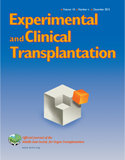Volume: 10 Issue: 6 December 2012
FULL TEXT
Key words : Lymphoma, Conditioning, Hematopoietic stem cell transplant
There are no randomized studies that compare the different conditioning regimens for lymphomas. Bone marrow transplant units worldwide must adjust to existing ones. Ramzi and associates present the results of their survey of 45 noncryopreserved autologous stem cell transplanted patients with Hodgkin lymphoma, treated with an alternative regimen known as “modified BEAM-like regimen” (CEAM regimen: lomustine, etoposide, cytarabine, and melphalan), in which carmustine (BiCNU IV) is replaced by oral lomustine (CCNU: 2 chloroethyl cyclohexyl nitrosourea).1
In our in-patient bone marrow transplantation unit, we use a similar regimen for non-Hodgkin lymphoma and Hodgkin lymphoma with differences in cytarabine and etoposide infusion; we also intend to use it on our out-patients. Our conditioning regimen is given to the patients as follows: CCNU 200 mg/m2 orally on day -4; intravenous etoposide 1000 mg/m2 on day -3 for 10 hours; intravenous Ara-C 2000 mg/m2 for 2 hours, twice a day, on day -2; and intravenous melphalan 140 mg/m2 on day -1. Since September 2011, we have been using this regimen on 6 patients with Hodgkin lymphoma and non-Hodgkin lymphoma. Besides the hematologic toxicity, there is no other level 4 toxicity. The most frequent adverse events are those related to the gastrointestinal treat. Despite the short observation time, event-free survival is 83%. There was 1 death related to treatment for sepsis, which was influenced by acute renal insufficiency in a patient with renal dysfunction (creatinine clearance, 51 mL/min). All 5 patients under treatment are in complete remission, and 2 of the 5 have a partial response by the time of the bone marrow transplant.
There are different regimens using lomustine but its association with melphalan, and the advantages of this association, are studied to a lesser degree.2,3 Conversely, whenever it is used with cyclophosphamide, the association does not need a day off, allowing a shorter conditioning period.
Lomustine is an oral drug with less pulmonary toxicity then carmustine.2 Because lomustine is an oral drug, we use it on the first conditioning day to avoid emesis that can reduce absorption of the medicines. After the first 6 patients were given 200 mg/m2 of lomustine, we began to increase the dosage to evaluate probable limitations after a progressive increase to a maximum dosage of 600 mg/m2 in a study on typical performance of 3 + 3.4
To the best of our knowledge, we do not know what is the best regimen for lymphomas autologous transplanted patients. New associations are being studied according to the needs of the different institutions around the world.
References:
- Ramzi M, Mohamadian M, Vojdani R, et al. Autologous noncryopreserved
hematopoietic stem cell transplant with CEAM as a modified conditioning regimen
in patients with Hodgkin lymphoma: a single-center experience with a new
protocol. Exp Clin Transplant. 2012;10(2):163-167.
CrossRef - PubMed - Chao NJ, Kastrissios H, Long GD, et al. A new preparatory regimen for
autologous bone marrow transplantation for patients with lymphoma. Cancer.
1995;75(6):1354-1359.
CrossRef - PubMed - Perz JB, Giles C, Szydlo R, et al. LACE-conditioned autologous stem cell
transplantation for relapsed or refractory Hodgkin's lymphoma: treatment outcome
and risk factor analysis in 67 patients from a single centre. Bone Marrow
Transplant. 2007;39(1):41-47.
CrossRef - PubMed - Hather GJ, Mackey H. Some notable properties of the standard oncology Phase I
design. J Biopharm Stat. 2009;19(3):543-555.
CrossRef - PubMed

Volume : 10
Issue : 6
Pages : 622 - 622
DOI : 10.6002/ect.2012.0091
From the 1Internal Medicine Department, School of Medicine; and the
2Bone
Marrow Transplantation Unit, University Hospital, Universidade Federal de Juiz
de Fora, Juiz de Fora, MG, Brazil
Acknowledgements: The authors have no conflicts of interest to be disclosed.
Corresponding author: Abrahão Elias Hallack Neto, Avenida Barão do Rio Branco,
2679,
sala 714, Juiz de Fora – MG, Brasil, CEP 36010-060
Phone: +55 32 8889 9881
Fax: +55 32 3215 1523
E-mail:
abrahallack@uol.com.br